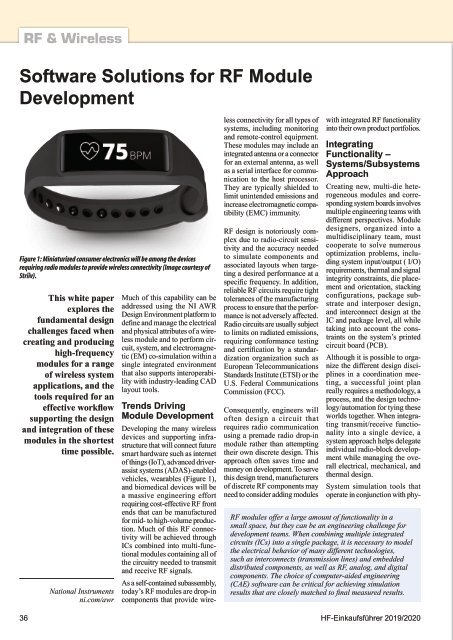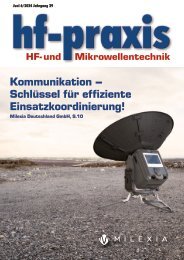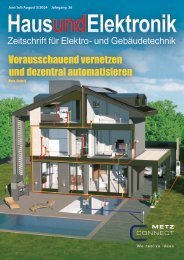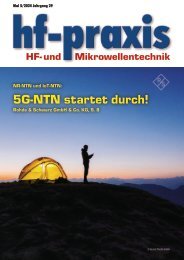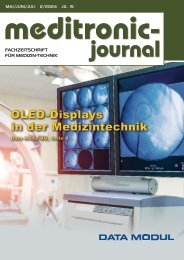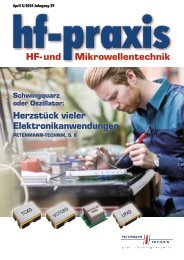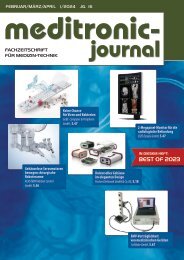EF 2019-2020
Fachzeitschrift für Hochfrequenz- und Mikrowellentechnik
Fachzeitschrift für Hochfrequenz- und Mikrowellentechnik
Sie wollen auch ein ePaper? Erhöhen Sie die Reichweite Ihrer Titel.
YUMPU macht aus Druck-PDFs automatisch weboptimierte ePaper, die Google liebt.
RF & Wireless<br />
Software Solutions for RF Module<br />
Development<br />
Figure 1: Miniaturized consumer electronics will be among the devices<br />
requiring radio modules to provide wireless connectivity (Image courtesy of<br />
Striiv).<br />
This white paper<br />
explores the<br />
fundamental design<br />
challenges faced when<br />
creating and producing<br />
high-frequency<br />
modules for a range<br />
of wireless system<br />
applications, and the<br />
tools required for an<br />
effective workflow<br />
supporting the design<br />
and integration of these<br />
modules in the shortest<br />
time possible.<br />
National Instruments<br />
ni.com/awr<br />
Much of this capability can be<br />
addressed using the NI AWR<br />
Design Environment platform to<br />
define and manage the electrical<br />
and physical attributes of a wireless<br />
module and to perform circuit,<br />
system, and electromagnetic<br />
(EM) co-simulation within a<br />
single integrated environment<br />
that also supports interoperability<br />
with industry-leading CAD<br />
layout tools.<br />
Trends Driving<br />
Module Development<br />
Developing the many wireless<br />
devices and supporting infrastructure<br />
that will connect future<br />
smart hardware such as internet<br />
of things (IoT), advanced driverassist<br />
systems (ADAS)-enabled<br />
vehicles, wearables (Figure 1),<br />
and biomedical devices will be<br />
a massive engineering effort<br />
requiring cost-effective RF front<br />
ends that can be manufactured<br />
for mid- to high-volume production.<br />
Much of this RF connectivity<br />
will be achieved through<br />
ICs combined into multi-functional<br />
modules containing all of<br />
the circuitry needed to transmit<br />
and receive RF signals.<br />
As a self-contained subassembly,<br />
today’s RF modules are drop-in<br />
components that provide wireless<br />
connectivity for all types of<br />
systems, including monitoring<br />
and remote-control equipment.<br />
These modules may include an<br />
integrated antenna or a connector<br />
for an external antenna, as well<br />
as a serial interface for communication<br />
to the host processor.<br />
They are typically shielded to<br />
limit unintended emissions and<br />
increase electromagnetic compatibility<br />
(EMC) immunity.<br />
RF design is notoriously complex<br />
due to radio-circuit sensitivity<br />
and the accuracy needed<br />
to simulate components and<br />
associated layouts when targeting<br />
a desired performance at a<br />
specific frequency. In addition,<br />
reliable RF circuits require tight<br />
tolerances of the manufacturing<br />
process to ensure that the performance<br />
is not adversely affected.<br />
Radio circuits are usually subject<br />
to limits on radiated emissions,<br />
requiring conformance testing<br />
and certification by a standardization<br />
organization such as<br />
European Telecommunications<br />
Standards Institute (ETSI) or the<br />
U.S. Federal Communications<br />
Commission (FCC).<br />
Consequently, engineers will<br />
often design a circuit that<br />
requires radio communication<br />
using a premade radio drop-in<br />
module rather than attempting<br />
their own discrete design. This<br />
approach often saves time and<br />
money on development. To serve<br />
this design trend, manufacturers<br />
of discrete RF components may<br />
need to consider adding modules<br />
with integrated RF functionality<br />
into their own product portfolios.<br />
Integrating<br />
Functionality –<br />
Systems/Subsystems<br />
Approach<br />
Creating new, multi-die heterogeneous<br />
modules and corresponding<br />
system boards involves<br />
multiple engineering teams with<br />
different perspectives. Module<br />
designers, organized into a<br />
multidisciplinary team, must<br />
cooperate to solve numerous<br />
optimization problems, including<br />
system input/output ( I/O)<br />
requirements, thermal and signal<br />
integrity constraints, die placement<br />
and orientation, stacking<br />
configurations, package substrate<br />
and interposer design,<br />
and interconnect design at the<br />
IC and package level, all while<br />
taking into account the constraints<br />
on the system’s printed<br />
circuit board (PCB).<br />
Although it is possible to organize<br />
the different design disciplines<br />
in a coordination meeting,<br />
a successful joint plan<br />
really requires a methodology, a<br />
process, and the design technology/automation<br />
for tying these<br />
worlds together. When integrating<br />
transmit/receive functionality<br />
into a single device, a<br />
system approach helps delegate<br />
individual radio-block development<br />
while managing the overall<br />
electrical, mechanical, and<br />
thermal design.<br />
System simulation tools that<br />
operate in conjunction with phy-<br />
RF modules offer a large amount of functionality in a<br />
small space, but they can be an engineering challenge for<br />
development teams. When combining multiple integrated<br />
circuits (ICs) into a single package, it is necessary to model<br />
the electrical behavior of many different technologies,<br />
such as interconnects (transmission lines) and embedded<br />
distributed components, as well as RF, analog, and digital<br />
components. The choice of computer-aided engineering<br />
(CAE) software can be critical for achieving simulation<br />
results that are closely matched to final measured results.<br />
36 HF-Einkaufsführer <strong>2019</strong>/<strong>2020</strong>


